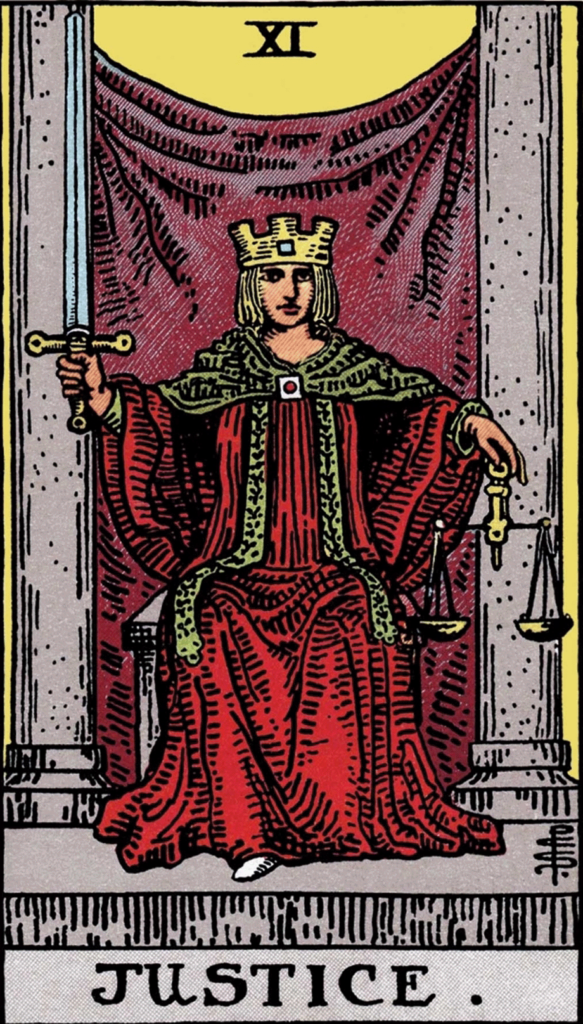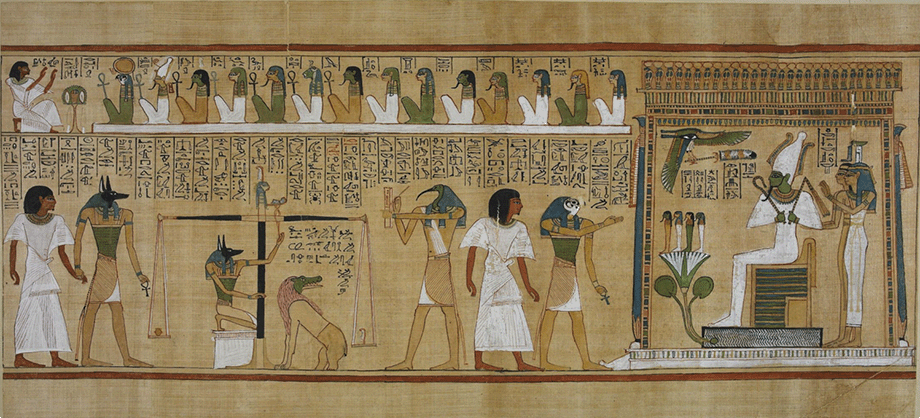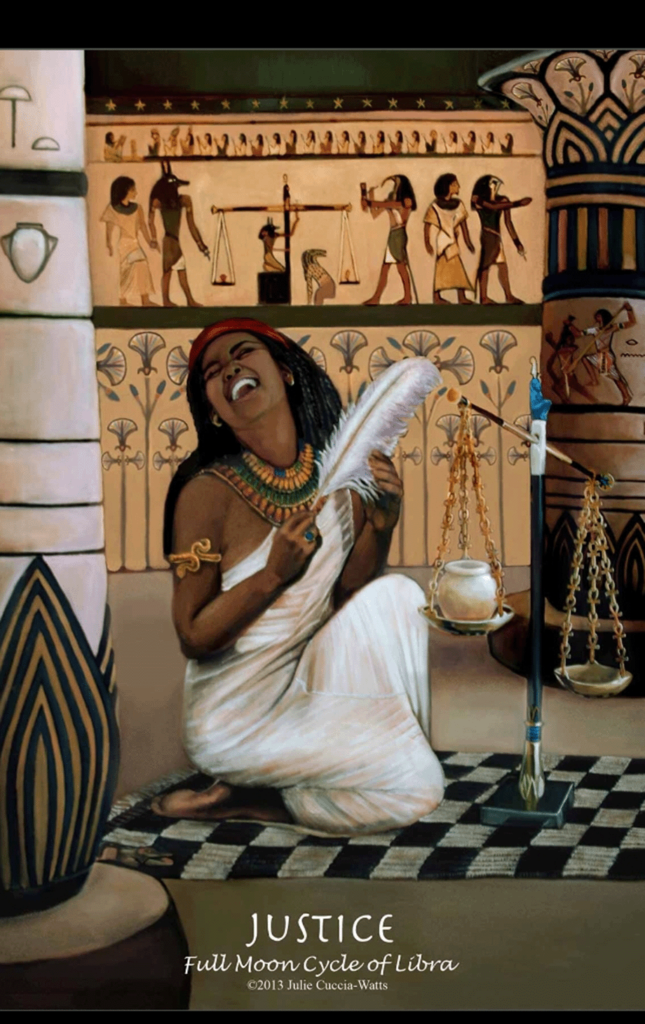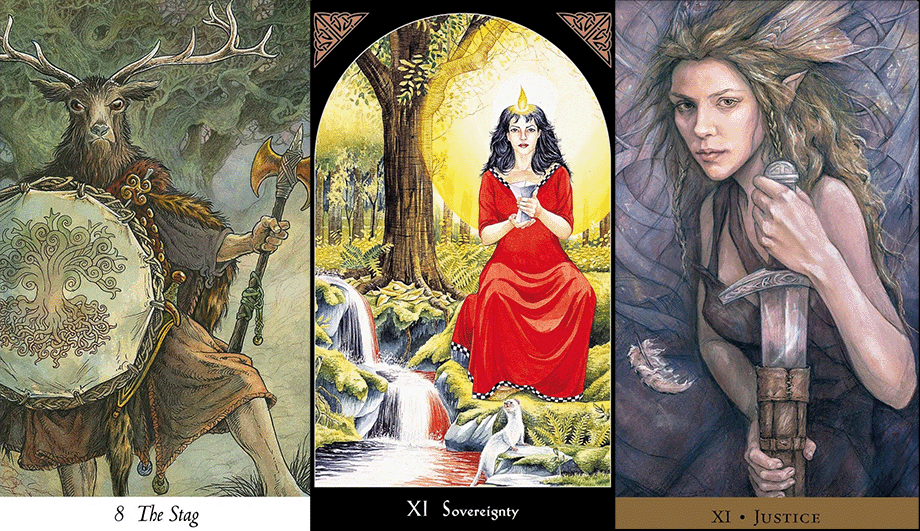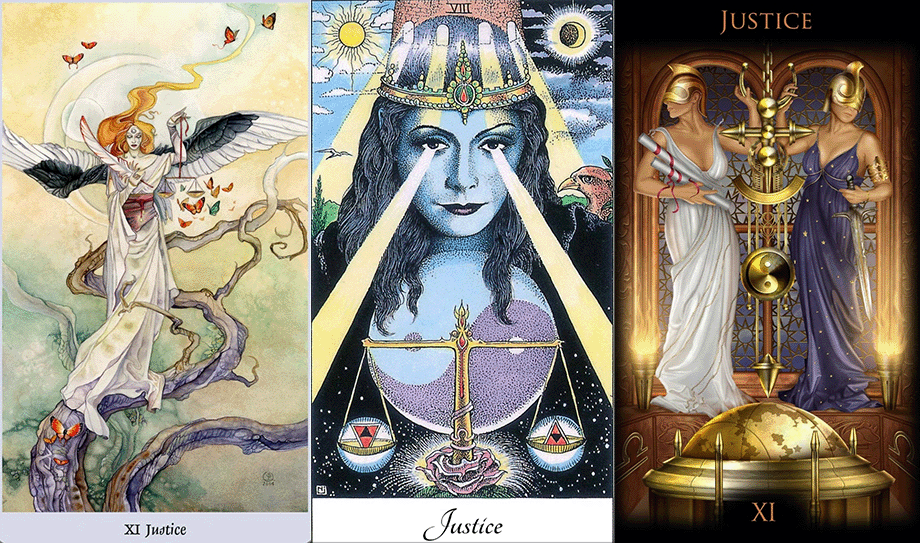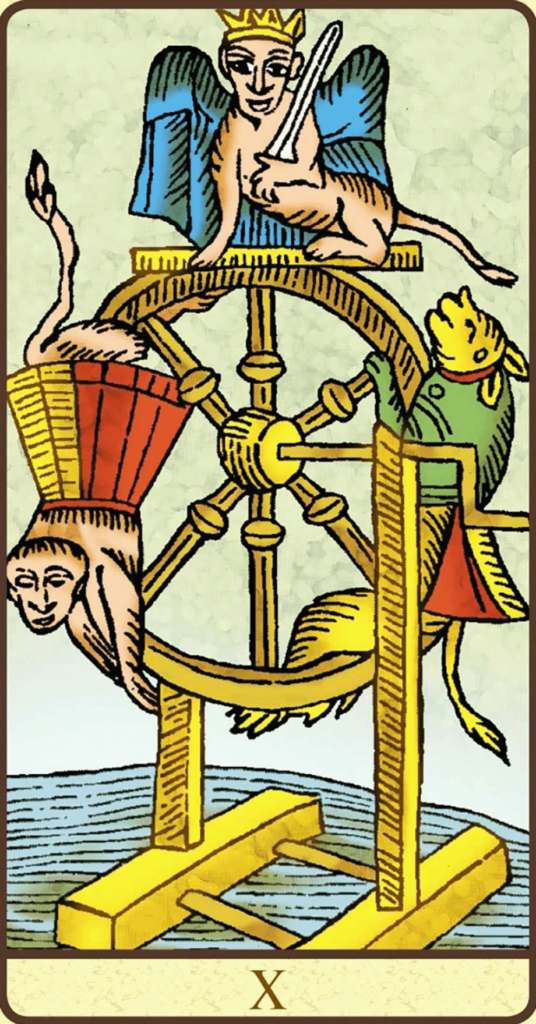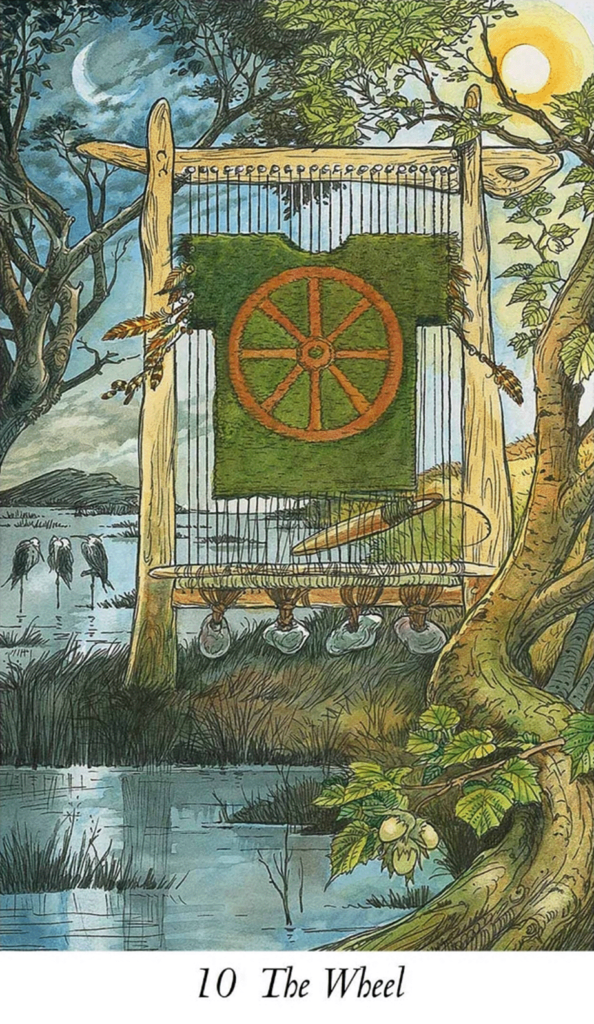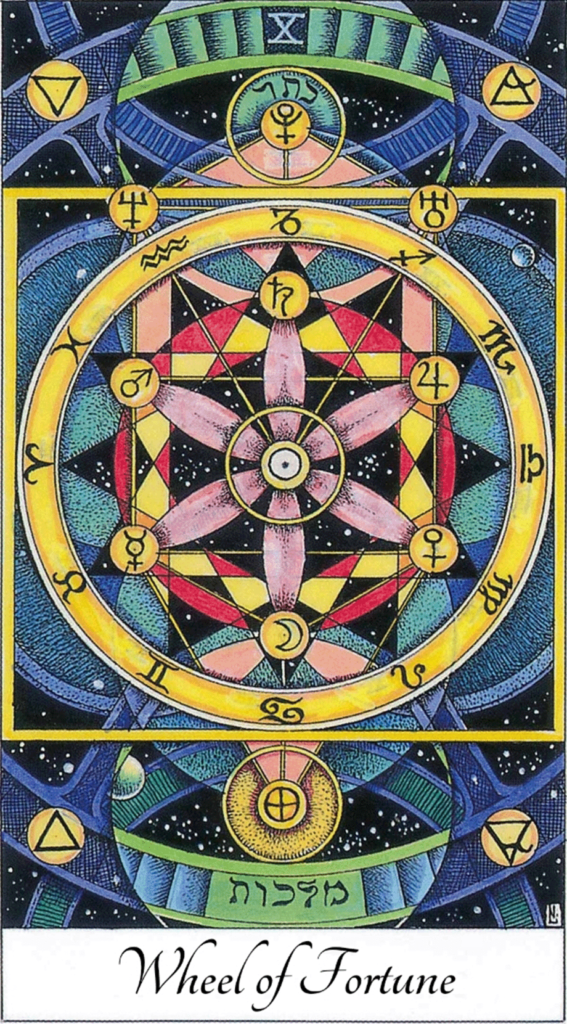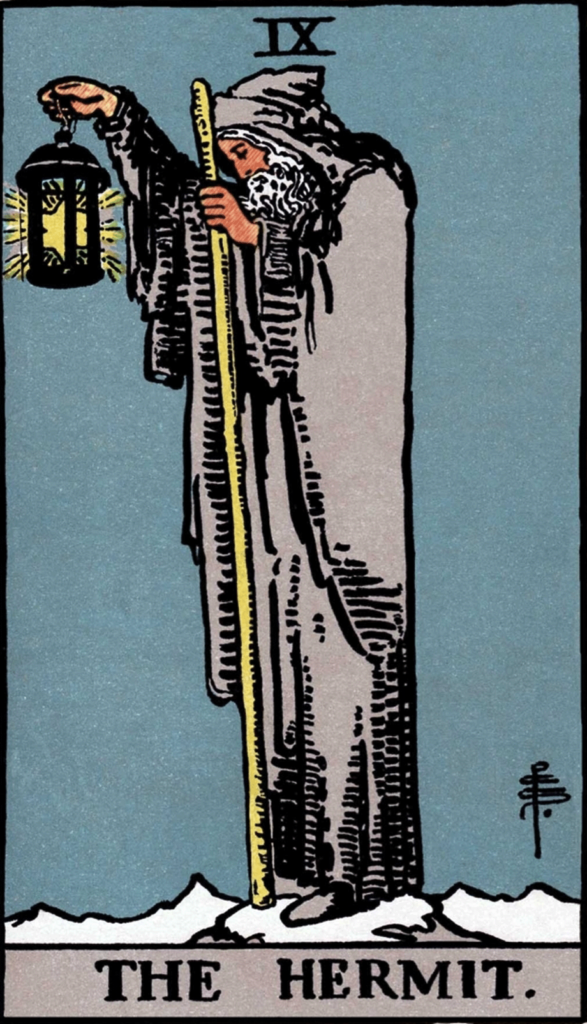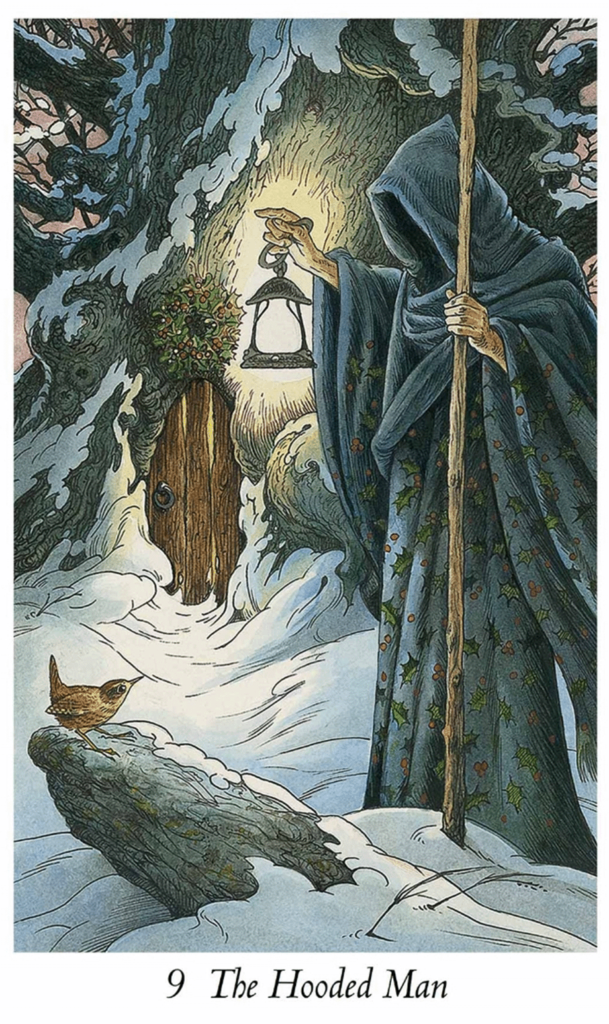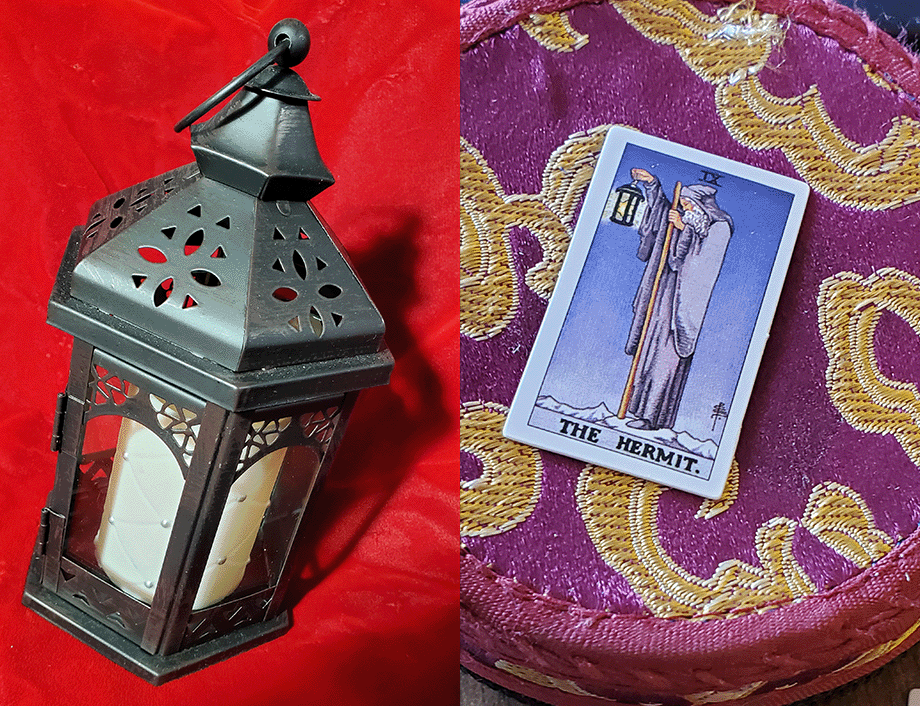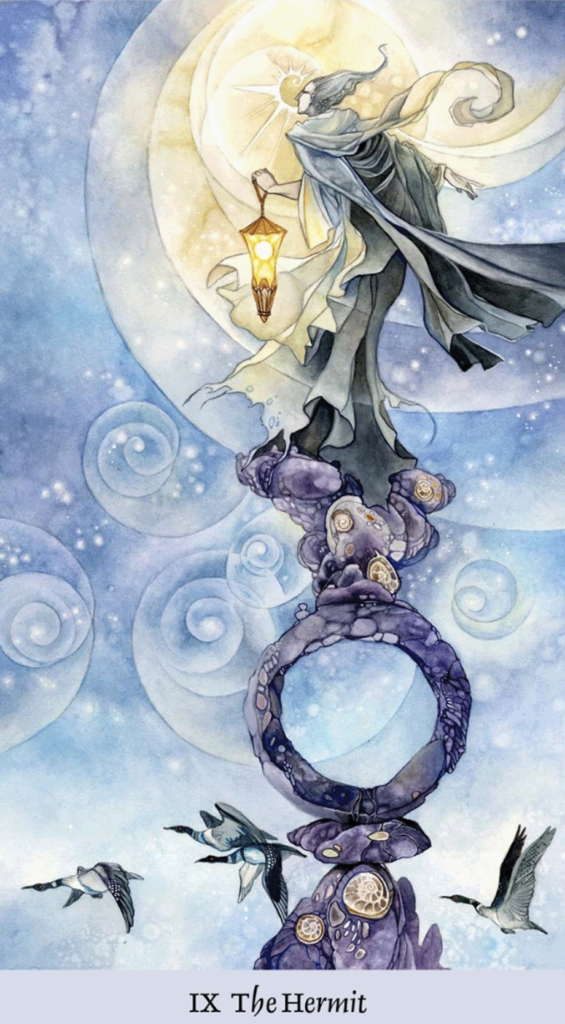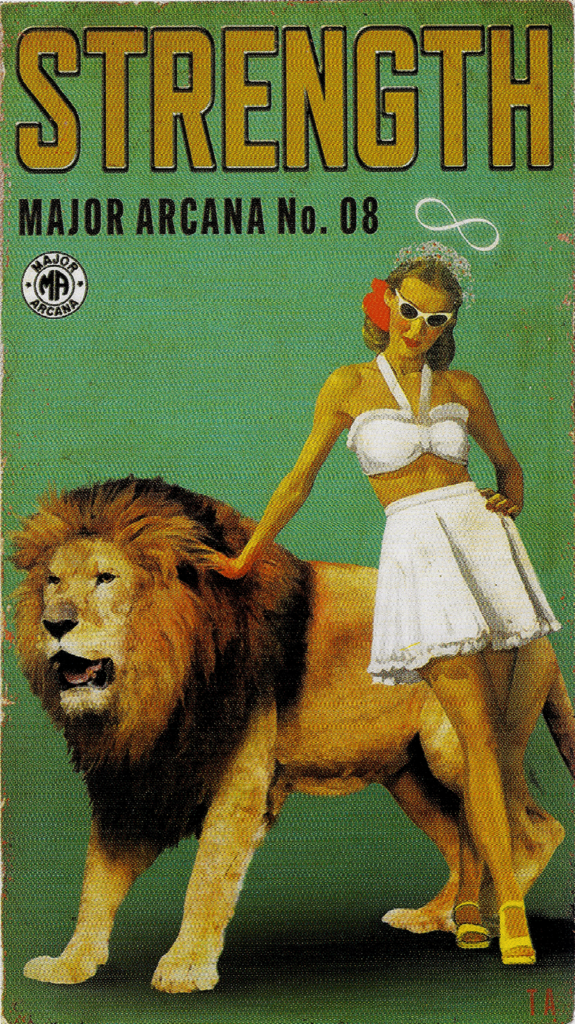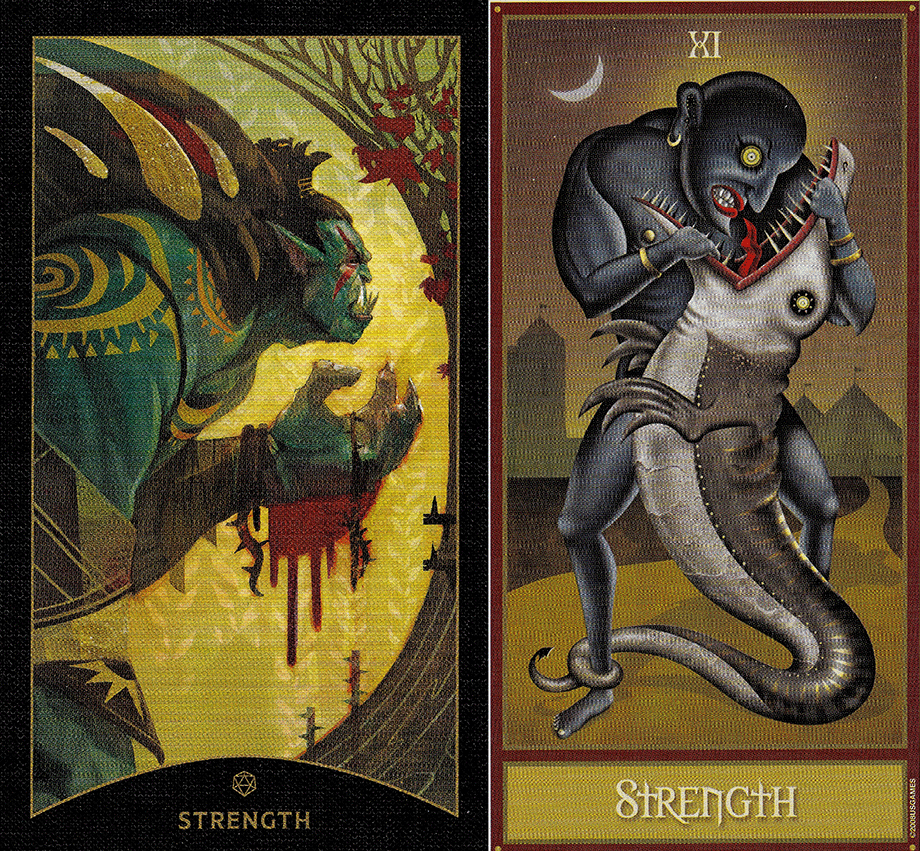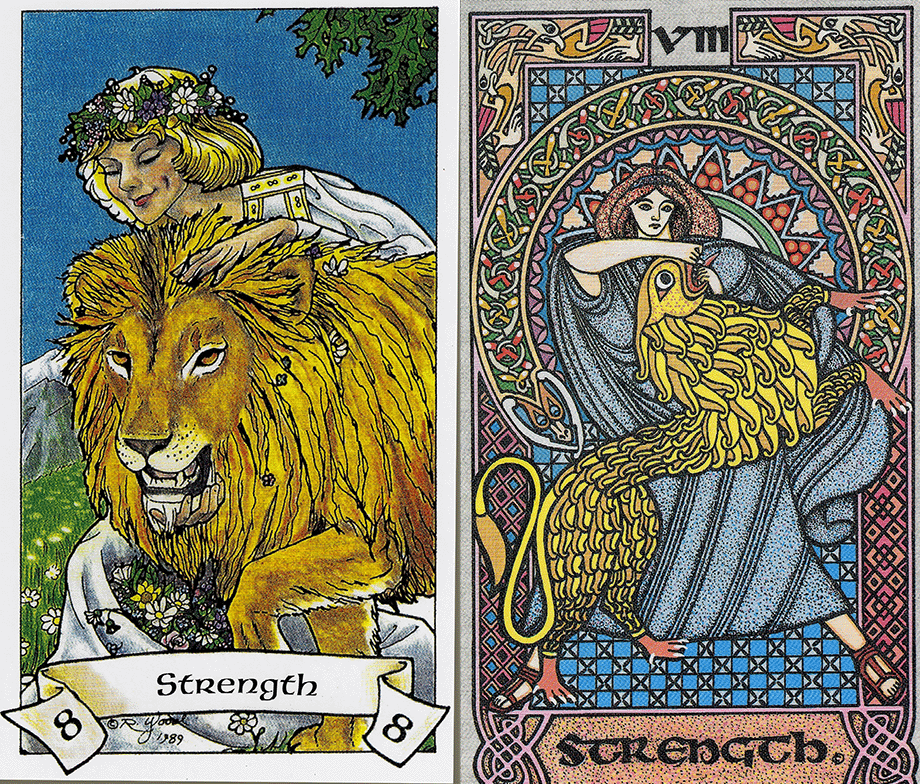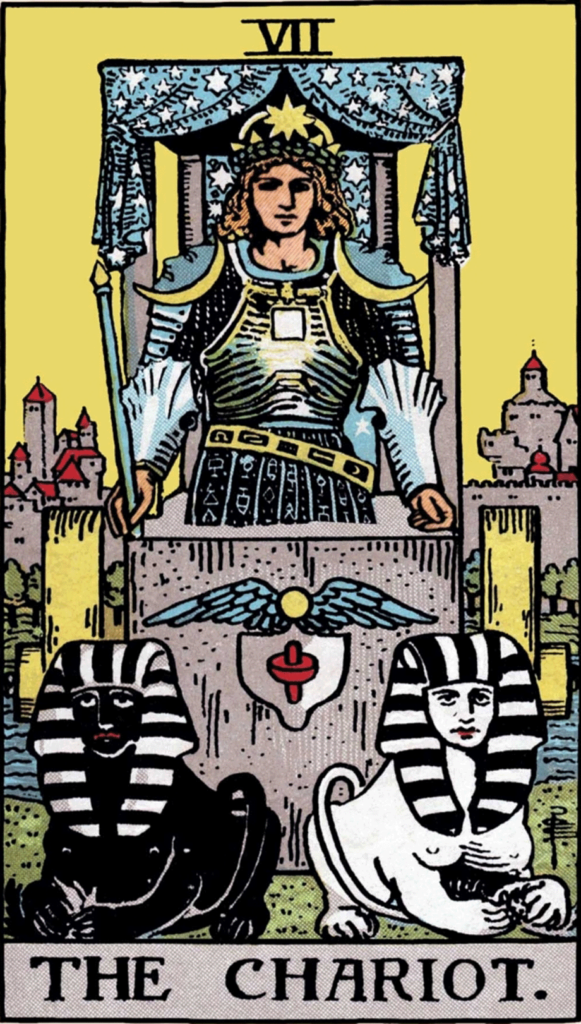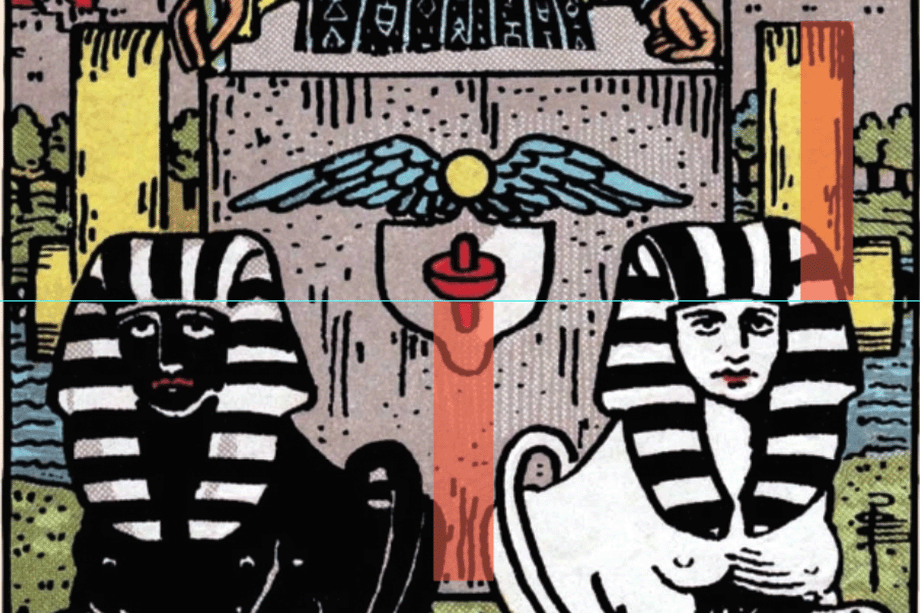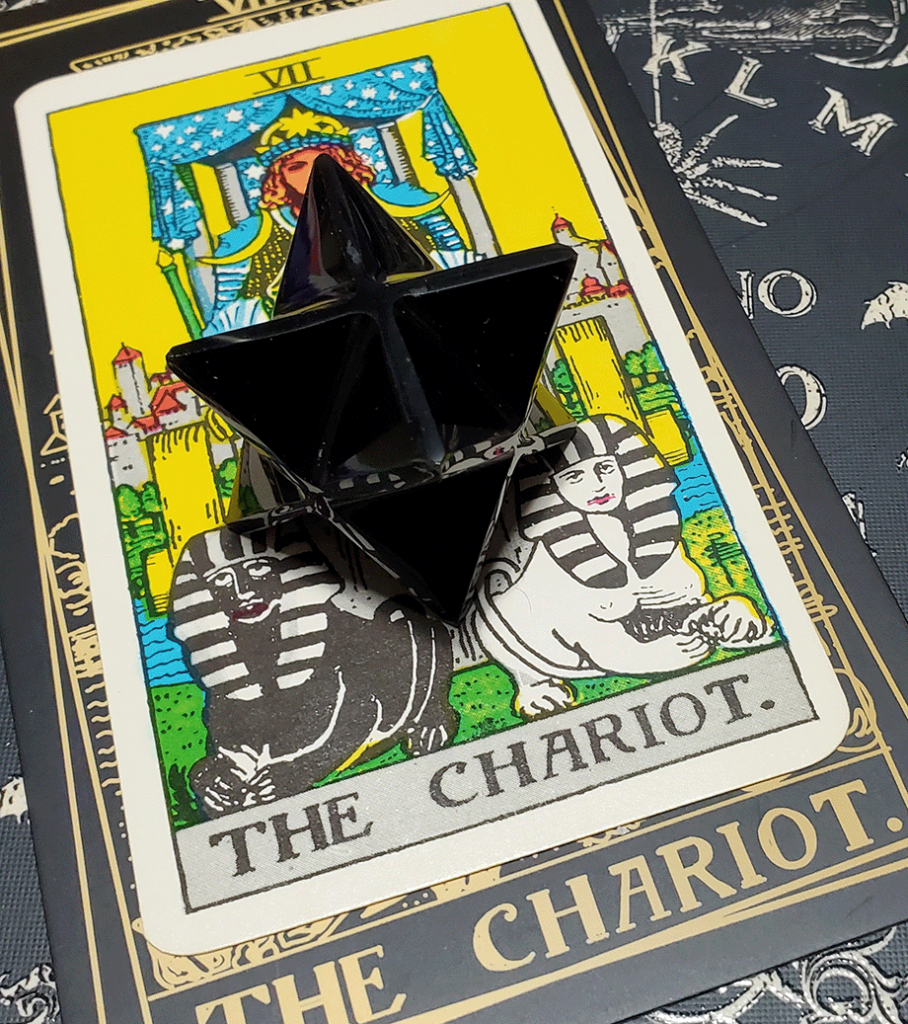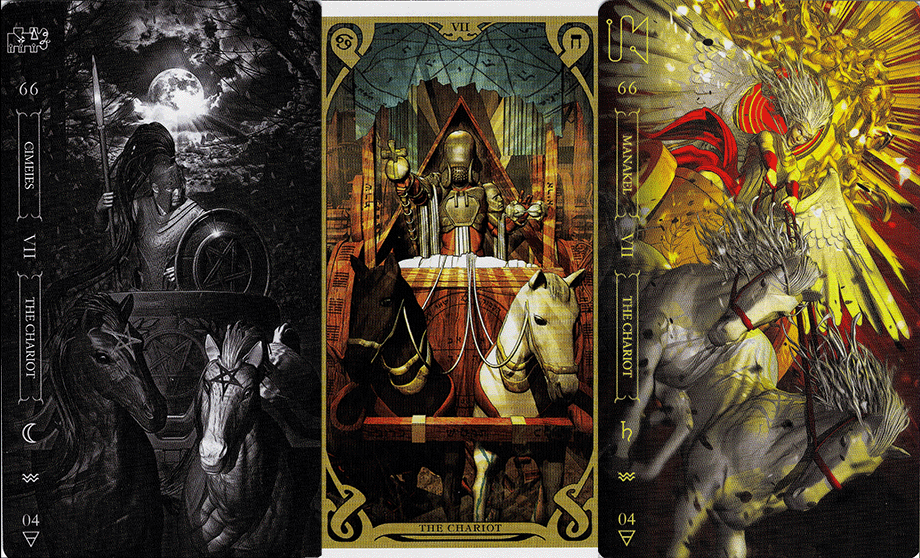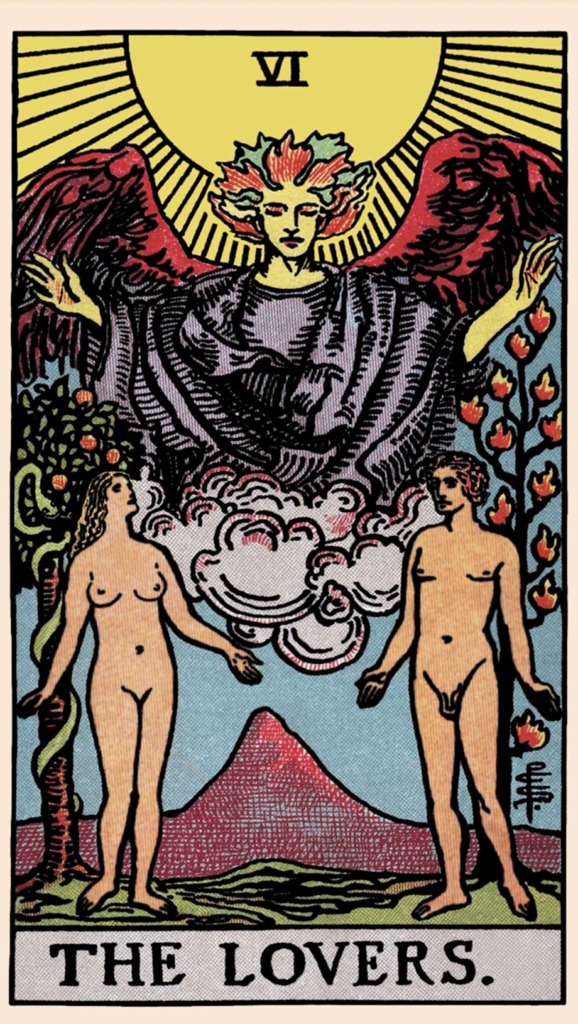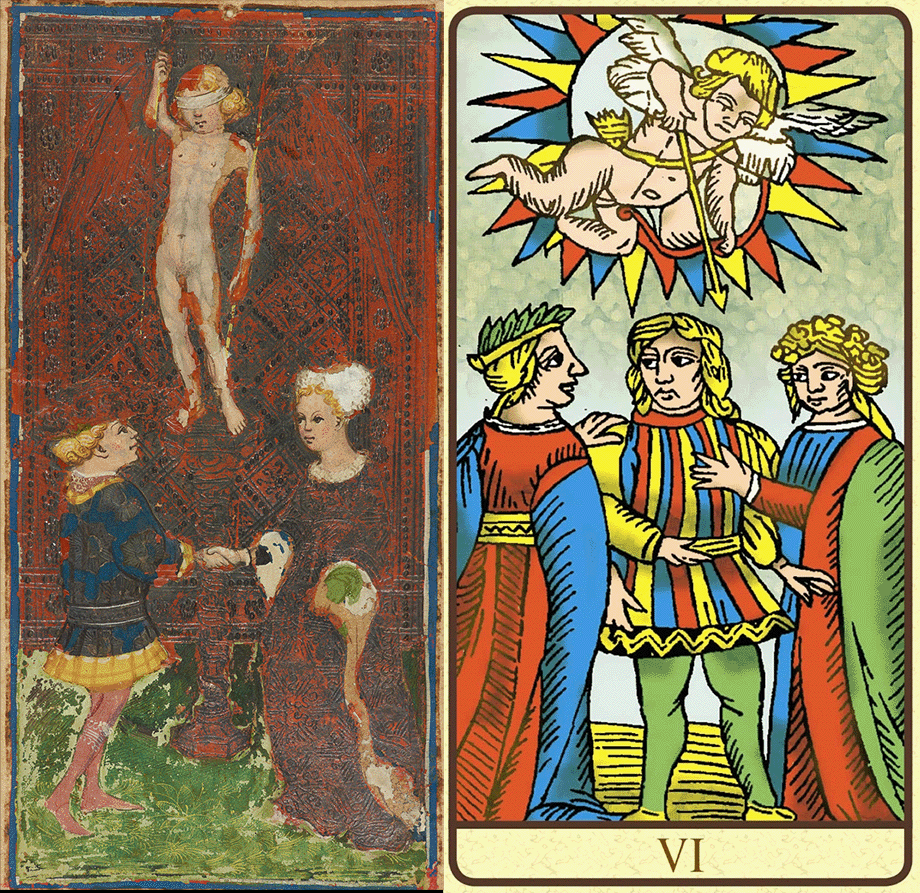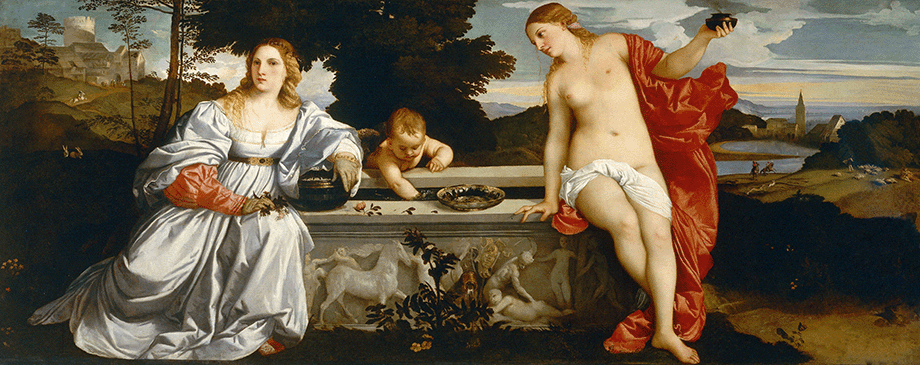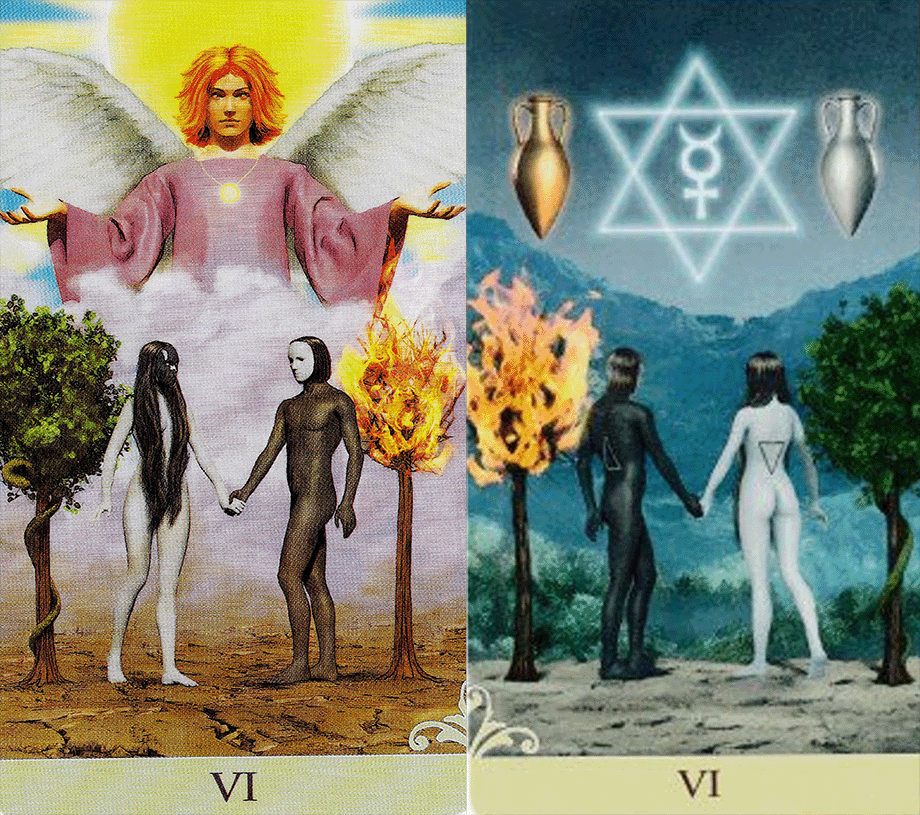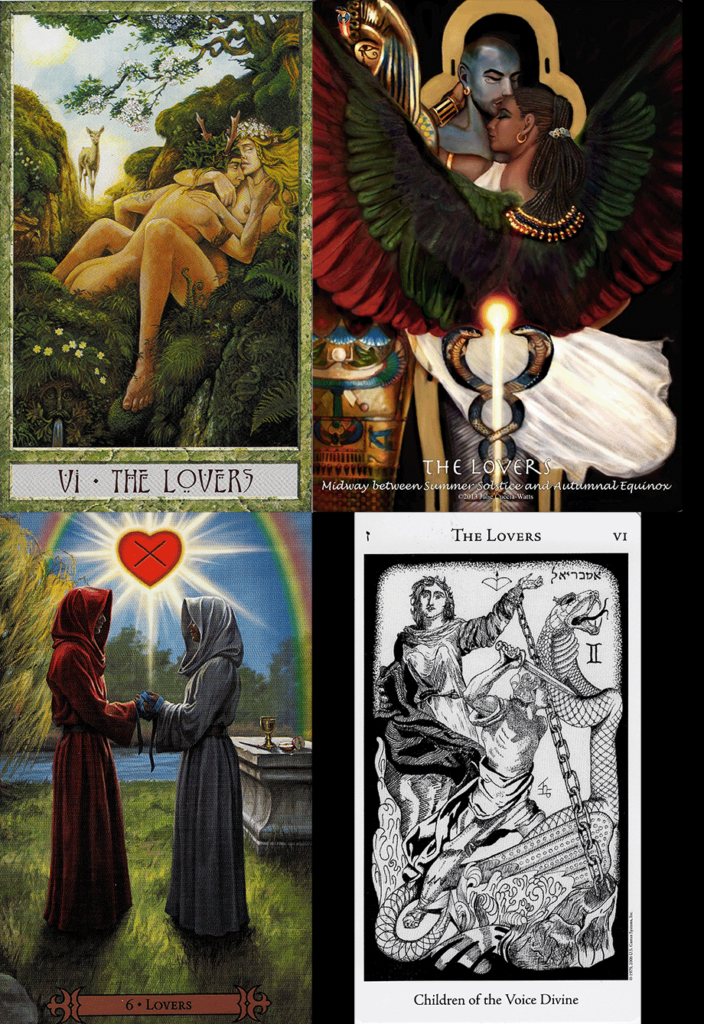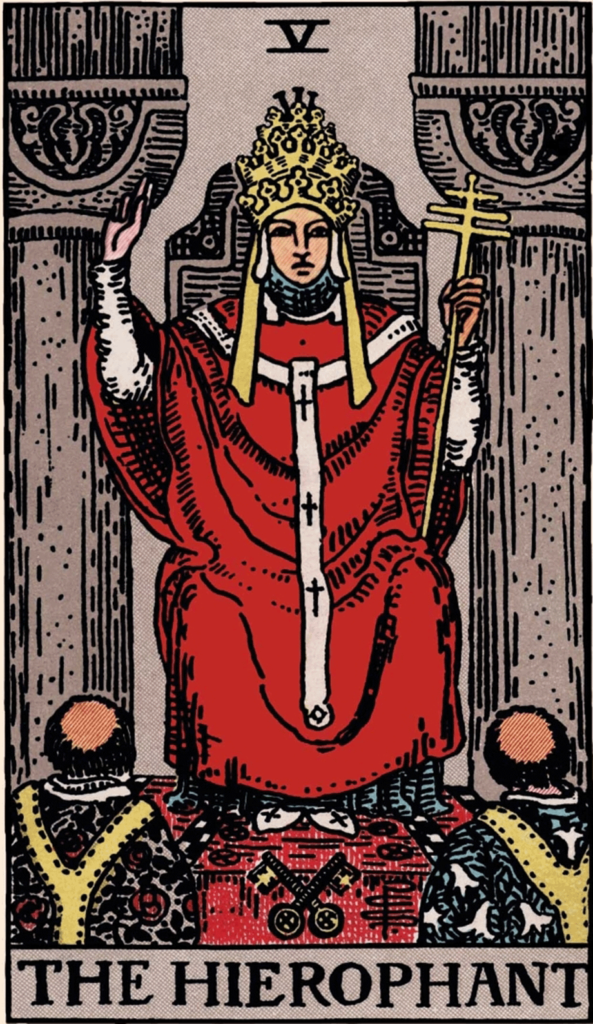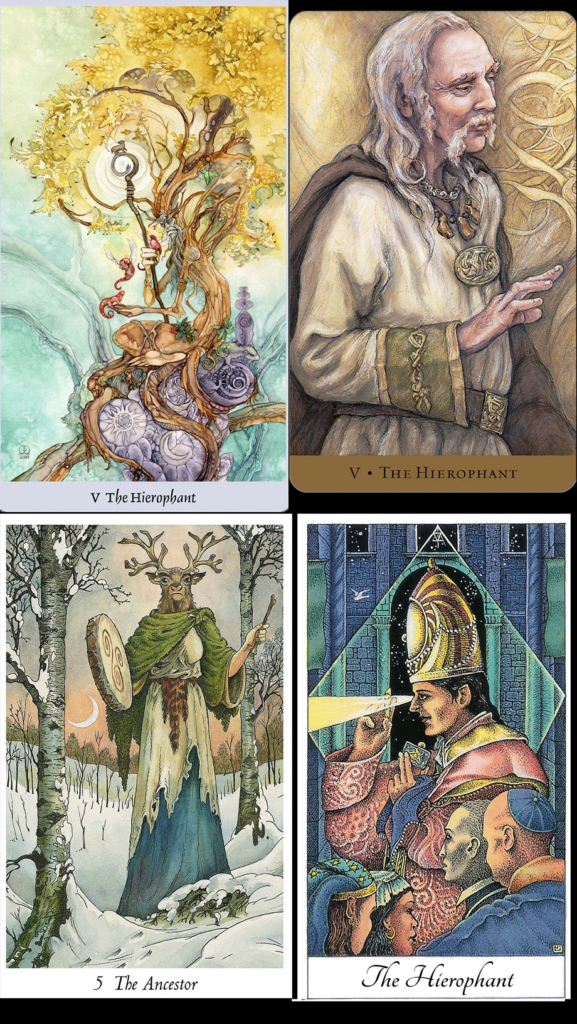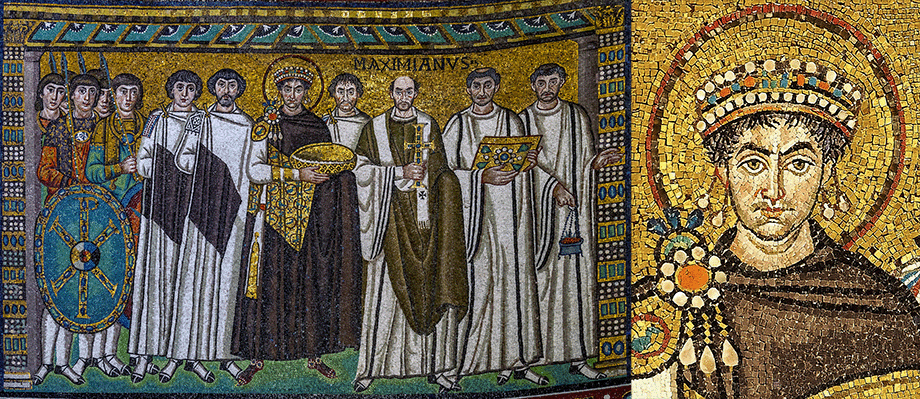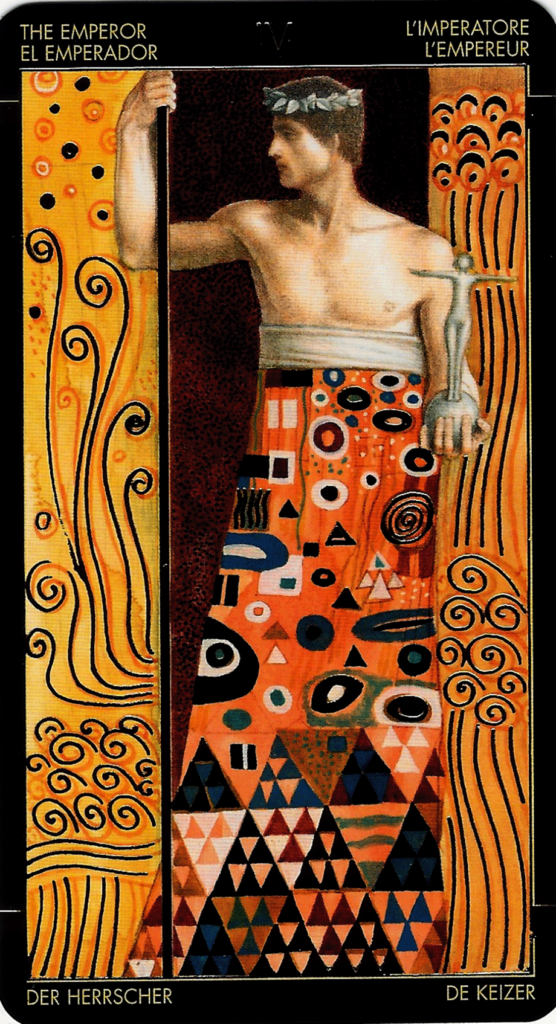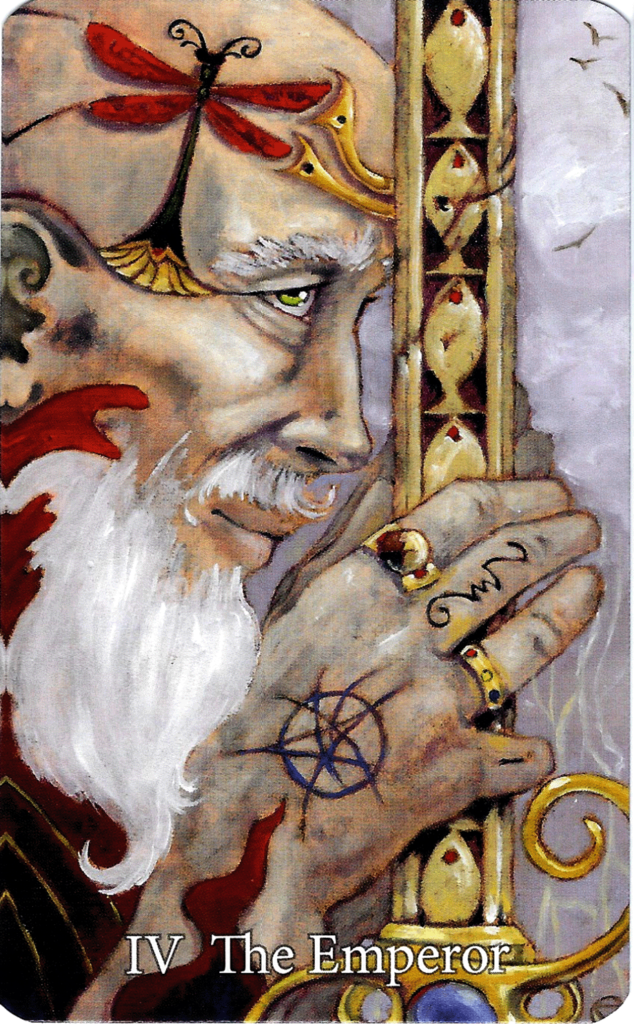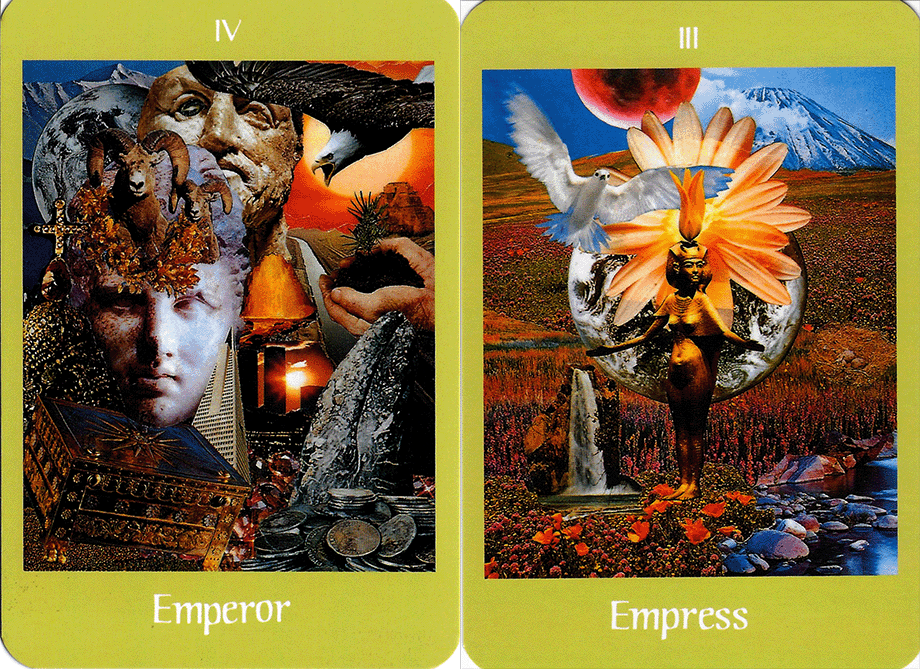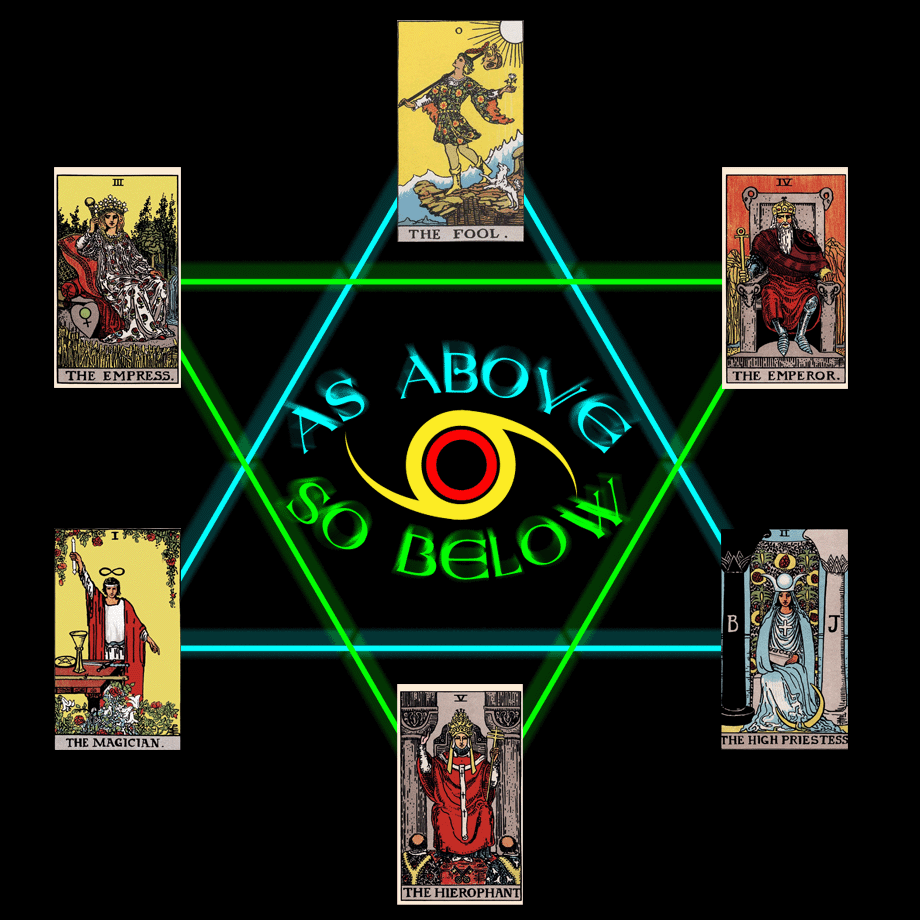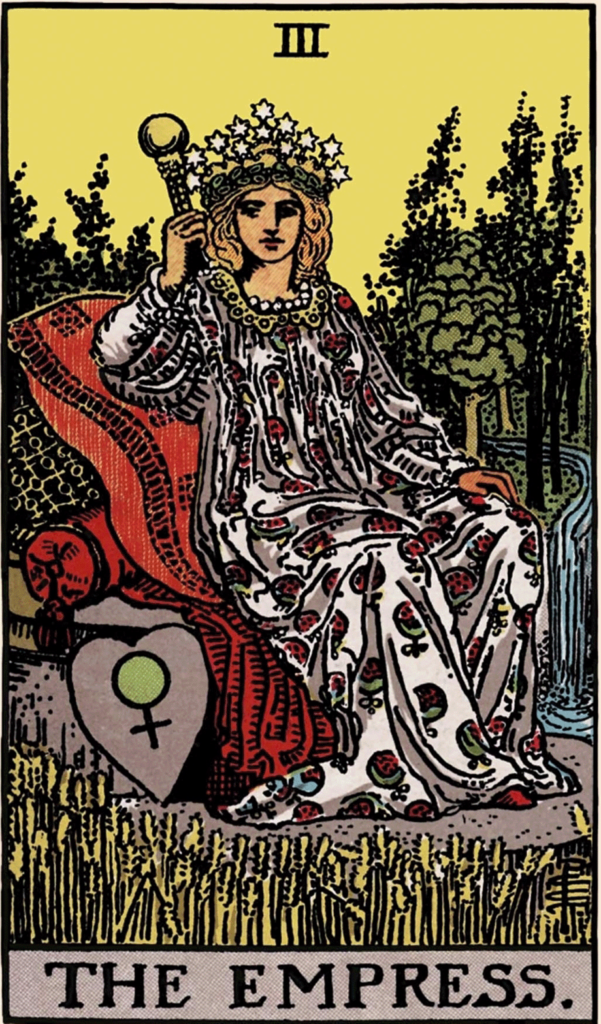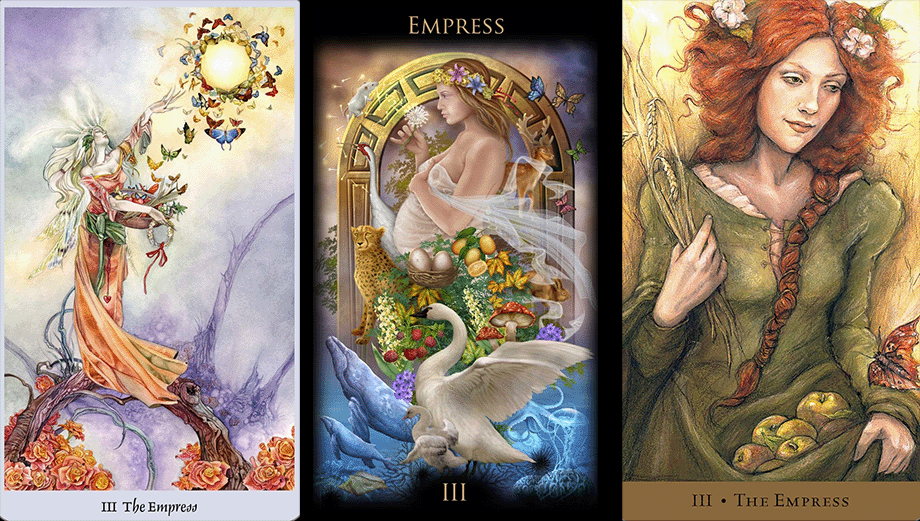I used the term “betwixt and between” as the title of an earlier article, but it is applicable here. The terms “heaven” and “hell” can also be somewhat accurate, in a context I will get to at a later point, but despite the seeming obviousness, “As Above, So Below” is not an apt rendition to deal with this thirteenth card of the Major Arcana, styled XII in a line after the O of the Fool. Behold, the Hanged Man. (I’m pronouncing that mentally as “hang-ed” in the Shakespearean fashion. I think it better suits it and sounds less like a kid’s paper game).

The Hanged Man is suspended by his right ankle, which is tied to the horizontal beam of a rough cross. His other leg drops down behind it and the bent knee causes it to mirror the cross beam above. His arms are bound behind him, possible around the upright of the cross. The wood of the cross appears newly hewn and has drooping leaves still attached, The figure wears humble soft shoes, red leggings, and a blue tunic. Behind the head is a halo of light. The background of this card is an empty drab grey.
This card’s meaning per Waite is emblematic of the Martyr God, Christ on the Cross, Odin on the Tree, and carries with it the context of secret wisdom gained at a sacrifice. By extension we can connect the murdered Osiris, and we are back in Ancient Egypt again, with the promise of resurrection and afterlife. From this springs the card as a symbol of transformation, of a change from one state into the next (though this is frequently assigned to the following card Death). This is therefore metamorphosis, a pupa in the cocoon. The past is gone, but the future is not yet written.
Originally this card depicted and was called the Traitor, and in place of his hallow was simple fire. He was being burned at the stake, or the gallows, upside down, for a crime against the state. While we can draw allusion to this being the fate of prominent martyrs such as Jesus and St. Peter, who was crucified upside down, there was not that original context. In the first flowering of Tarot, this was a bad man, who met a bad end. It was justification for the power of the state, to mete justice, and execute prisoners, which was shifting from a Divine Right and ecclesiastical authority, to a secular humanist one. Ironically this symbolized the shifting between two points that I frequently find the Hanged Man represents.
As noted, St. Peter is reputed to have required the Romans to hang him upside down on the cross, since he felt he had failed Christ and was unworthy to have the same death as his master. The inverted cross is nowadays associated with the idea of Anti-Christ and Satanism, though these distinctions I believe are more the result of the popular film culture of the sixties and seventies than any legitimate tradition. Inverting a cross, might have been a ritual of the so-called Black Mass, which included saying the Lord’s prayer and other holy texts backward, in a mockery of the Catholic rite. The Black Mass is possibly a whole creation of the Inquisition and Witchfinders. If it was practiced by witches in the 17th century and later, they may simply have been aping the alleged process, rather than following any specific tradition or teaching. The story of Peter may be apocryphal as well. One of his distinctions in the Biblical story is that he denied Christ three times during the trial and crucifixion. This idea of him inverting the Cross might indicate some esoteric tradition where he was a final time, disassociating himself with the faith he was considered guardian to. Bear in mind that the inconstancy of Peter is symbolic of the difficulty of following a philosophical discipline when faced with the temptation and privations of worldliness. In such an instance, one might find themselves “hanging in the balance” between doing what is good for their soul, and what is pleasurable to their body. It is not a coincidence that this idea stems from contemplation of this card.
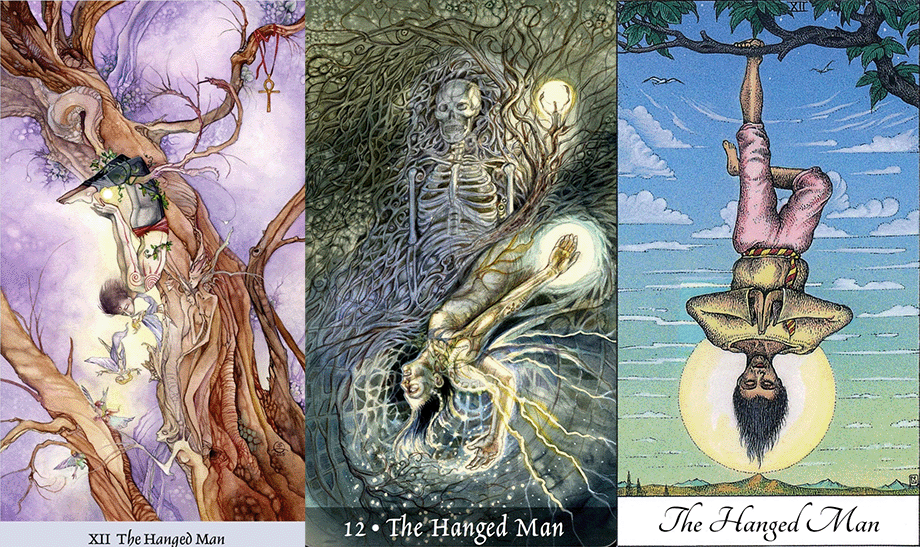
In the Shadowscapes version, the figure reminds me of Peter Pan, at play with the faeries in the forests of Neverland. If we look upon the Hanged Man as symbolic of this transitory moment, of being neither one thing or another, then perhaps the perpetual child from Barrie’s classic is as apt a metaphor as any. There is, however, a possibly darker meaning here. The Egyptian ankh hangs on an upper branch. We find the ankh prominently figured in the Thoth Tarot of Aleister Crowley. The Hanged Man is suspended from it. Yet here he is separated. indicating, perhaps, that he falls, or hangs between, this life and the next.
Certainly this is more evident in the central card. The Ghosts and Spirits deck can be a disturbing read at times. The imagery is powerful, complex, and often horrific. We might see here a Tree of Death, instead of the Tree of Life. Yet many of the cards in this deck need to be interpreted as expressing the journey of the spirit outside the flesh, so in this case, like the Shadowscapes, we are possibly witness to a soul in between incarnations.
The Cosmic Tarot has a lot of Hindu and Buddhist overtones, in addition to other magic systems. If we view the Hanged Man similarly here, we might be looking through the Barod Thodol, commonly called the Tibetan Book of the Dead, where the spirit is trying to free itself of the entanglement of desire, so to break the endless cycle of reincarnation and merge back in the the Nothing That Is Everything (i.e. the Fool Card). If he let’s go, he is bound to fall to earth, and into another fleshly incarnation. The balance between is a means of avoiding incarnation, but it cannot be maintained. Only by eliminating the I, can the illusion be shattered.
There are several other possible connections that we can make when dealing with the Hanged Man. A notable one that often springs to my mind is that of the infant Zeus, taken by his mother Rhea and given to the nymphs. In one version of the story, he is kept suspended from a tree, touching neither the earth nor the heavens, and is thus kept invisible to Chronos, his father, who wants to kill him to avoid the prophecy that Kronos will die by the hands of his children. This idea that the Hanged Man occupies a kind of non-space is interesting.
The idea of Limbo is a Catholic expression of the place between places, which in “Neither in Heaven, nor Hell, nor upon the Earth”. Its place in the Catholic dogma is utilitarian. It resolves certain questions regarding the fate of those who, though they led just and noble lives, were not born under the covenant of the Christian Baptism. Per this doctrine, Christ when passing through death at the crucifixion comes first to Limbo, and redeems the souls there, such as Adam and Eve, Moses, and the other Hebrew chosen.
In theory, this would mean Limbo ceased to exist with the Resurrection, but there is an unofficial doctrine that says it now contains the souls of unchristened children, who, innocent of all but the original sin of humanity (i.e. they were born after Adam and Eve ate of the Tree of the Knowledge of Good and Evil). Since they did not receive the initial tabula rasa by the Rite of Baptism, they technically weren’t going to get into Heaven, but as they didn’t live long enough to actually give into that sinful nature, it wasn’t proper to send them into the torments of Hell. According to variations on this theme, during the Final Judgment foretold in Revelation, these lost children will be redeemed and allowed to ascend into Paradise.
Some Protestant offshoots also believe that Limbo is where all souls are waiting for the Judgment Day, when the physical resurrection will occur and the world will become an earthly paradise. We’re getting a bit ahead of ourselves here, as all that happens with Cards XIX and XX in a few weeks.
Getting back to our Hanged Man, I want to delve into one of those personal epiphanies that I have had over the years of working with these cards. Now, I will here caveat that the Unverifiable Personal Gnosis is just that. This is something that came from inside my head, possibly from a source I know not where, and there is little to no external verification of it as legitimate, or useful. That said, Tarot is an intuitive experience. Imagination is the key to using the toolkit, and this series of articles is about taking the cards beyond the face value, beyond potential connections and inferences, and letting the images on the cards inform your mind. So, onward.
At some point in recent years, not longer ago that a decade or so, but not so recently that i can readily remember. I started forming the impression that the Hanged Man is falling. Like the figures from the Tower, he has not hit the ground, nor is he on a firm point where he started from. I don’t know if there is a version of this card in one of my decks that started me thinking this way (I will endeavor to look before publication, but there’s a lot of decks to go through, and so far it’s not one of my usual ones).
Secondary to this, I also got the distinct impression that this person falling was the Morningstar, That is, Lucifer the Fallen Angel, who would later become synonymous with Satan, the Devil, etc. Obviously the Devil has his own card a few steps hence, but here again is that card between one state and the other. This is the Fall from Grace. It dovetails quite nicely with the idea that this card was originally a symbol of betrayal and treason to the established order, and that this was the punishment.
I confess to a bit of Luciferianism, in the sense that many depictions of the Fall and the Rebellious Angel are metaphor for the development of our own human psyche from the animal one we used to inhabit. Like his Greek counterpart Prometheus, Morningstar is being punished for bringing to man the Fire of the Gods. The gods feared what man might do with it, and justly so. We’ve really managed to foul things up with the exothermic reaction, and it’s numerous toxic by-products. Yet once the deed was done, the extreme punishment seems overkill given the nature of the crime.
Prometheus has his liver plucked out daily. Satan is cast into the pit of Hell. Adam and Eve are barred from the Garden “lest he put forth his hand, and take also of the tree of life, and eat, and live for ever”.
Seems awfully vindictive to me. So the question here with the Hanged Man, is, was Justice served? Coming as it does on the heels of that card, I am forced to wonder if we are meant to perceive this as righteous punishment. Again, I am not typically one adherent to the idea of a linear “Tarot journey” but I think there’s a relationship inherent in the order of the cards here. And that brings us back to the question of the placement of the Justice card as XI rather than Strength, which occupies that slot in some versions of Tarot.
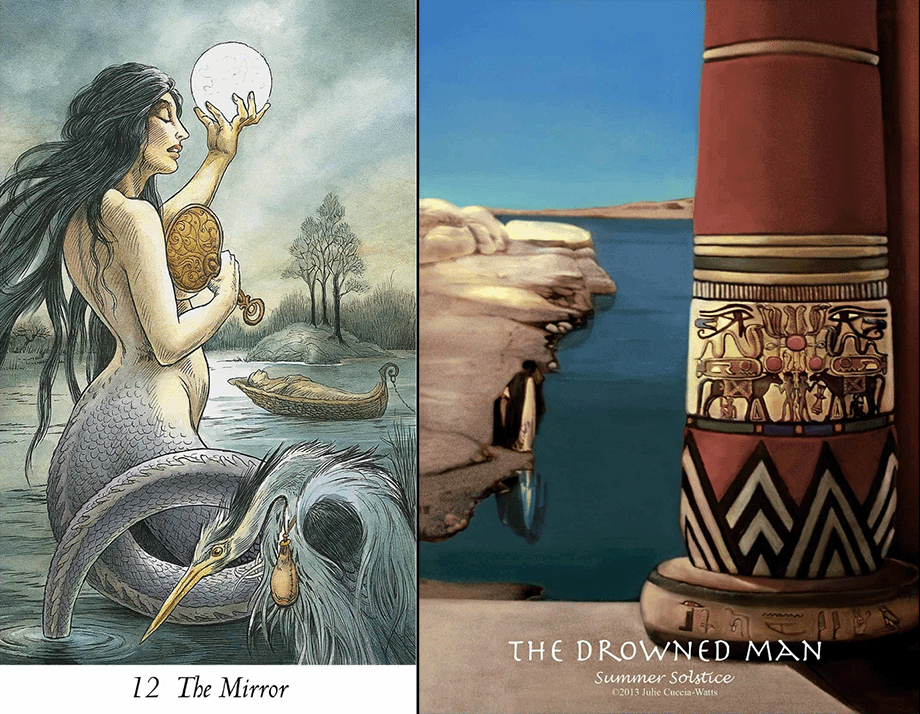
Wildwood works from a kind of Pre-Celtic or Proto-Celtic shamanic perspective, but often ties to the later Arthurian myth and Grail stories. The authors would appear to believe that the Arthur stories are a folklore from this more ancient time, and are simply retold in the wake of the fall of Roman Britain as the chivalric romances. In this case, we are confronted by a water spirit, which could as well be called a kelpie or similar name, holding a bronze mirror and a seeing stone, In the foreground is one of the heron’s we see in the Wheel image from a couple of weeks back, with a small sack around its neck. Behind them is a boat, which appears to hold a corpse. The boat is anchored or tethered. Behind the boat is an island with three trees. The text accompanying this card has a good number of esoteric ideas. It says also that many aspects of the traditional Hanged Man have been moved onto the Blasted Oak, which is this deck’s version of the Tower. I personally see the falling man from the Tower card having something in common with the Hanged Man, but here he is the figure in the boat, neither on this shore or the next. While the death metaphor seems very obvious, the text says this is about initiation, about reaching a point of injury or pain, that allows one to being open to the voyage to the island and healing. It is, according to the authors, not a journey that may be sought, but one that comes to us.
The Journey To Egypt deck is an amazing artistic expression. It diverts from the traditional take on the cards and yet manages to still impart much of that message. The figure here in isolation in the background, does not appear to be drowned. He is on the shore and apparently high and dry. Look again. His reflected self in the water is our Hanged Man, upside down, the world wrong side up. The man on the shore is bound to the man in the water. Neither of them are going anywhere. On facet of this deck is that it associated each card with astronomical events. I think it rather interesting that this one represents the Summer Solstice, which is the day this article is being released.
Remember that all of the cards are unnumbered in the original versions. The respective values of these cards in the Tarocchi game would seem to be more or less equal, so the ordering and numbering seems to have occurred when they began to be used by the adepts for purposes of divination. Levi gives us an order based on Kabbalah and the Hebrew Letters. He potentially inherits that from earlier sources, and later creators keep it roughly the same with the exception of cards VIII and XI. Justice might logically precede execution and death. But then justice might also fit between the force of an established state symbolized by the Chariot, and the isolate contemplation of the individual in the Hermit. It’s a question as to whether Strength fits better between the random chaos of the Wheel and the uncertain suspension of the Hanged Man. If Strength is the assertion of the Will over Nature- even individual nature, then a possible reading of the Hanged Man is equilibrium in the space of Chaos. He is not punished for having done wrong, he is simply unable to find a firm footing in an unstable universe. He cannot cling to the dogma he knows to be false, nor can he firmly embrace the totality of free will and personal responsibility because there is no assurance of accuracy or correctness. He lives in a quantum reality where the actual nature of things is only known by probability, potentiality, and only known too late. There’s no wonder that he is in torment.
There’s always some context where the seeker has to identify with the Rebel Angel. There is a point in our exploration of the universe and our own minds where we will question the truth of everything. We are not venerating in this sense, only stating that we can, in some way, feel empathy with Prometheus chained to that rock, waiting for the vulture to come again with the dawn. For Prometheus is aware of that eternal agony that what we believe to be true is always under threat from our own spiritual growth. We can either be content to remain ignorant, celebrating blind faith in something that we ourselves doubt, or risk the eternal damnation of never really being sure of anything ever again.
So we hang there on the tree, neither in Heaven or in Hell, unable to free ourselves to fall to the ground, or to climb back up to where we started from. In many ways this is a very pessimistic card, and they tend to get less cheerful from here.
I can only offer that there is a quiet to living in Limbo that can be very freeing, or at least restful. You know that change is coming. Change is inevitable. Yet now, you have the satisfaction of having endured change, and perhaps the confidence that you can endure the change to come, so being betwixt and between is not necessarily a bad thing. It’s hard to take any calls there.
I thank you for reading this week’s article. I am attending Heather Graham’s Writers for New Orleans later this week, where I will be part of a panel on occult subject matter. I will be reading Tarot for some of the folks in attendance, for the first time in many years. I am looking forward to seeing how the experience of articulating my views of these cards here will impact my readings, and I am wondering how the experience of cold reading will impact the remaining articles in this series. Since next week we face down Card XIII, with all the baggage it carries along, it should be informative. I hope you will join me then.



